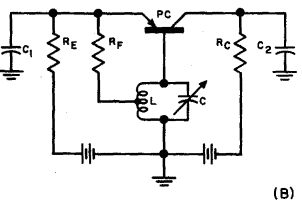| Transistor Basics is a free introductory textbook on transistors and their basic applications. See the editorial for more information.... |

|

Home  Transistor Oscillators Transistor Oscillators  Transistor Phase Shift Transistor Phase Shift  Phase Shift Compensation Phase Shift Compensation |
||






|
||
|
Phase Shift CompensationAuthor: Leonard Krugman
Fig. 6-13. (B) Base-controlled phase compensated oscillator. One method of increasing the available feedback is to connect a resistor from the emitter to a tap point on the base tank coil. This provides regenerative voltage feedback to supplement the inherent current feedback of the circuit. The value of the resistor RF is critical. The upper limit of the oscillator frequency drops as RF is either increased or decreased from its critical value. For this reason, the feedback resistance is best determined on an experimental basis. Figure 6-13 (B) illustrates a basic oscillator incorporating these two methods of phase shift control and compensation.
|
||
Home  Transistor Oscillators Transistor Oscillators  Transistor Phase Shift Transistor Phase Shift  Phase Shift Compensation Phase Shift Compensation |
||
Last Update: 2010-11-17


